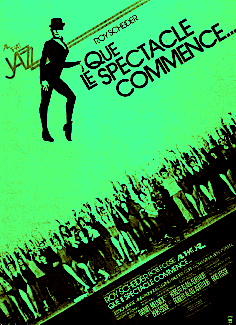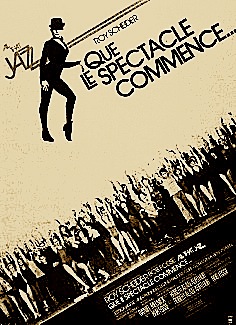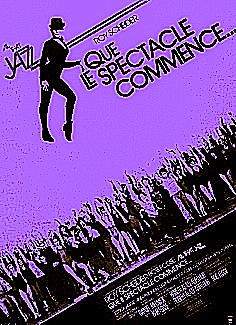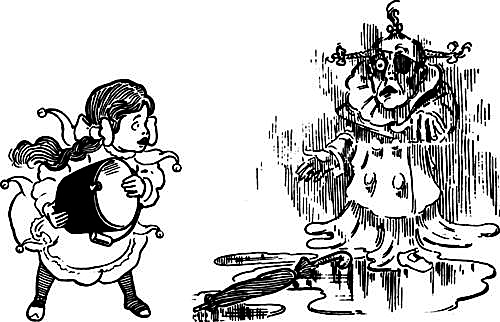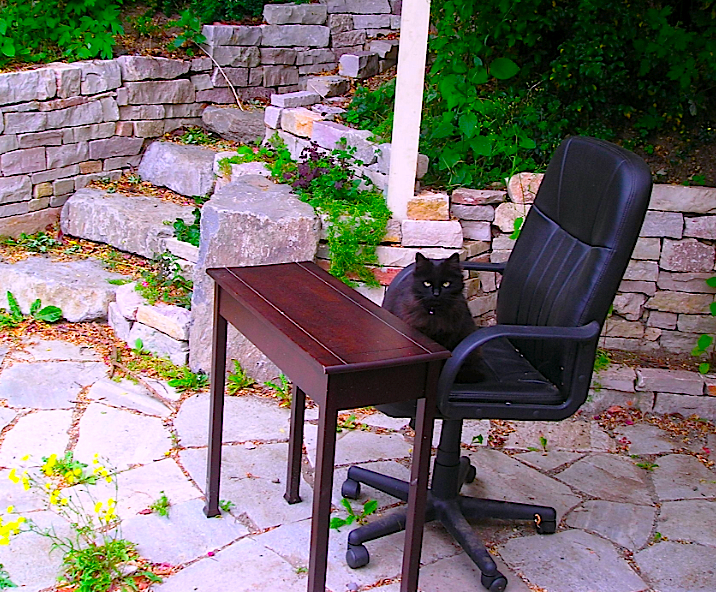
No, I’m not going to be writing about my trip to France again today — since we’re already into literary conference season, I’m going to give that a break for a while. Starting next week, I’m going to revisit those two perennial conference terror-inducers, formal pitch meetings and informal hallway pitching.
Stop groaning, those of you who lived through previous summers’ accounts of these difficult tasks: every writer could benefit from spending a little time brushing up on the old verbal self-promotional skills, because, frankly, the extremely common assumption that a good book is easier to pitch than a bad one is just not true. Pitching, like query writing, is a learned skill, and speaking as a writer whose agent had told at 4 am at a literary party, “Pitch your memoir to that editor standing over there,” I can assure you that authors are indeed expected to be able to pitch their own work for the rest of their professional lives.
But relax: so as not to spoil your Fourth of July holiday, I’m not going to start right away. Have a seat; drink something cool as you watch the fireworks. I’ll just keep running pretty pictures of France and Spain because, let’s face it, people who write and edit for a living don’t get out to take pictures all that often.
In the meantime, remember how I told you a few months back that I often glean my best ideas for series from readers’ questions? Well, for the next few days, I’m going to revisit a craft issue that several readers have asked me to clarify — and to make easier to find on this website. To both ends, I’m pleased to unveil a new category on the archive list on the lower right-hand side of this page: INTERVIEW SCENES THAT WORK.
That’s right: for the next few days, I’m going to concentrate upon one of my all-time favorite species of expendable text: the kind of dialogue that results from a protagonist’s being a really, really poor interviewer.
I heard that tittering out there. Seriously, a protagonist who doesn’t ask good questions — or necessary follow-up questions — can slow a novel, memoir, or creative nonfiction book to a limping crawl.
Why does it matter how skilled a questioner the protagonist is, you ask, unless s/he is a journalist of some sort? Simple: many, many, MANY novel plots require their protagonists to learn something that they do not already know — and, more importantly, that the reader does not already know.
Who killed the Earl of Cheswick, for instance, or why so many people are interested in that darned ugly Maltese Falcon. In the pursuit of answers to these and other burning questions, the protagonist is, necessarily, frequently forced into the role of interviewer, trying to extract information from other characters.
What a pity, then, that protagonists have a nasty habit of slowing down the collective search for truth by neglecting to promising lines of questioning, failing to follow up on something just said, or just plain being too polite to ask the questions the reader is dying to ask herself, but can’t.
As so often happens when I have planned to attack a particular issue, craft or promotional, in this venue, the Fates trundled up with a wheelbarrow and dumped an excellent example right at my feet, the kind of real-life incident that novelists and memoirists alike love to incorporate into their narratives. See if you can catch the narrative problem with this tale:
Last Sunday was my mother-in-law’s 70th birthday (many happy returns, Marge!), and thus the occasion of an eight-hour buffet-and-chatting marathon in her daughter’s back yard/poultry coop. As befits my Cool Auntie status, I devoted much of my party-going time — as much as was left after making the dining room table groan with yummy, easily-portable foodstuffs, that is — to the resident children and their ever-changing interests. On this particular day, my 8-year-old niece’s interests centered primarily upon gerbils and the bread loaf-sized cupcakes she had helped me pile up temptingly at 10 am, yet was not allowed to gobble down until after 2 pm.
A child’s life is so frequently cruel.
To distract Pansy (not her real name, but a cunning substitute) from all of that sugar, I asked for a guided tour of Gerbil Central. Not unnaturally, the gerbils were not altogether pleased to be picked up, placed upon a warm tabletop, and told to sit, stay, and roll over. Clearly, this was going to end in tears. “Are they allowed on the lawn?” I asked brightly, scanning the skies for hawks. “Or will they burrow and escape?”
Pansy thought this was a terrific idea. “Oh, no. They just like to wiggle through the grass.”
The gerbils had no comment, nor did they seem to find the grass much more engaging than the shredded cardboard in their terrarium. What did seem to interest them was scurrying under a discarded paper plate, peeping out fearfully to see if some raptor had shown up to cart them off for brunch.
After some minutes, Pansy decided that their furry lives could use a bit of cultural enrichment. She leapt to her feet, a petrified gerbil in each hand. “I’m going to introduce them to the poultry!”
Now, call me timid, but had I been gerbil-sized, I would have found the two-foot turkeys my brother-in-law sees fit to be raising as a combination educational experience for his young/Thanksgiving main course quite terrifying. “I don’t think you should do that, Pansy. Since birds are their natural predators, the turkeys will scare them.”
“I know.” Since I was holding her back, Pansy held the gerbils up over her head, so they could get a good eyeful of the pecking beasts. “I want them to learn that when they’re with me, they’re safe.”
“That’s rather complex logic for rodents. They’re not all that good at drawing conclusions.”
After I had finished explaining what a conclusion was and why she was better at drawing them than anything at all likely to inhabit a terrarium, Pansy agreed to lie down in the grass and let the gerbils play. Instantly, the gerbils fled under the paper plate again.
The girl watched them for a while, mildly amused by my distracting patter. Unable to stand the sight of all of that unmolested furriness, she scooped up the nearer gerbil and tried to convince it to cuddle up on her stomach. The gerbil attempted again and again to beat a hasty retreat, but was inexorably dragged atop Mt. Pansy again, told it was loved, and ordered to stay still. Eventually, it gave up on descent, contenting itself with burrowing under her T-shirt.
“Bow chicka wow chicka WOW-WOW,” Pansy sang.
“I beg your pardon?” I cried, unaccustomed to small children belting out the greatest hits of adult movie soundtracks.
Like any good performer, Pansy was glad to provide an even more spectacular encore, accompanied by an interpretive dance. “Wow chicka WOW chicka WOW-wow chicka wow chicka WOW-WOW.”
I glanced at her uncle, the gentleman who had brought me to this shindig and a craven soul who was valiantly pretending that he had never seen this child, the gerbil, or me before. “Um, honey, do you mind telling me where you learned that song?”
“I don’t know.” She hauled the gerbil out of her shirt so she could serenade it. “Bow chicka wow chicka WOW-WOW-WOW!”
I hoisted myself off the lawn with a speed virtually guaranteed to leave grass stains. “Who’s up for a cupcake”
Catch the problem? If you pointed out the extremely common one of an actual event’s being substantially funnier to live through than to read, give yourself a gold star for the day. If you mentioned that I told the story, as so many recorders of real life do, as if any reader’s reactions would have been identical to mine in the moment, award yourself another. If you blurted out something about my having told what happened, instead of showing it — an interpretive dance could cover a lot of different types of action, right? — be mighty pleased with yourself. If you said that I was attributing thoughts to Pansy that the first-person narrator of this piece could not possibly have heard without being clairaudient, pat yourself on the back yet again.
Good job. Now — what would be the single easiest way to revise this scene to render it more engaging to the reader? (Hint: the title of this post is a major clue.)
That’s right: by making the narrator a better interviewer. Had I asked more insightful questions of either myself (why did the song disturb me so much? Did it have something to do with the time I heard an entire van full of 11-year-olds sing Madonna’s “Like a Virgin” at the top of their lungs on my first day as an after school program volunteer all those years ago?) or of Pansy (did she realize that adults associate that particular kind of music with something she’s not supposed to know about for years to come, or had she simply heard in on a commercial? Was she trying to provoke a specific reaction in me, her uncle, the gerbil?), I could have rendered the situation more dramatic while simultaneously doing more character development. I also could have avoided that hackneyed scene ender that we’ve all seen so often in TV shows and movies, the protagonist’s running out of the situation in order to avoid conflict that would have been interesting on the page.
Some of you are just dying to register an objection, aren’t you? “But wait — you were reproducing real-life dialogue,” all of you would-be objectors point out. “Wouldn’t it be less realistic if you changed it?”
In a word, no. In several words, not if I write the scene well.
As I’ve observed many times before and shall no doubt again, just because something actually happened doesn’t mean it will automatically read realistically on the page. It’s the writer’s job to craft dialogue — or any scene, for that matter — so it’s plausible, not the reader’s to make allowances because the writer observed someone saying or doing what ended up on the page. Besides, real-life dialogue is often dull.
That’s especially true in interview scenes, incidentally: few narrative devices annoy professional readers (like agents, editors, contest judges, and our old pal, Millicent the agency screener) who’ve been at it for a while than a narrator — or protagonist — who is a lousy interviewer.
Why? Well, for starters, lousy interviewers are so very common in submissions. On a manuscript’s page, a poor interview scene tends to run a little something like this:
“I swear,” Reginald claimed, one hand over his heart and the other hovering over the graying head of his sainted mother, “that’s all I know. Please don’t ask me any more questions.”
Janet drummed her long piano-player’s fingers on the rich mahogany tabletop. Her every instinct told her that he was not telling the truth — or at least not the whole truth. The very fate of Western civilization rested upon her solving this puzzle before midnight tomorrow, and this one well-protected, diamond-encrusted lady obviously held the key.
She stood and offered her hand to the old woman. “Charming to meet you, Mrs. Fezziwig. You must come to my house for brunch sometime. I hate to boast, but I make extraordinary deviled eggs.”
Reginald detached their clasped hands so quickly that Janet’s hand burned. “Must you go so soon? Here’s your coat — I’ll walk you down to the cab stand on the corner before I release the vicious dogs that prowl our estate at night to discourage post-midnight visitors.”
Janet fumed, but what could she do? “Goodbye,” she called back from the hallway.
“Don’t forget to sprinkle your eggs with paprika,” she could hear Mrs. Fezziwig bellowing after her. “I love paprika.”
Why would an exchange like this prove annoying to a professional reader? For the same reasons that my story about Pansy might strike ‘em as underdeveloped: because the scene a lost opportunity for interesting conflict — rich potential for drama presented then abandoned by the narrative for no apparent reason.
Okay, so that’s not quite fair: writers often have what they consider pretty strong reasons for rushing their protagonists away from conflict. Trying to make them more likeable to the reader by demonstrating common courtesy, for instance, or forcing them to work harder to learn the Awful Truth.
Or wanting to stretch the novel from 100 pages to 200. My point is, regardless of the motive, this practice tends to render those of us who read manuscripts for a living a trifle impatient.
Why? Well, in essence, the protagonist becomes the reader’s surrogate in ferreting out information; as a reader, it’s not as though I can jump into the storyline, grab a microphone and tape recorder, and start grilling the usual suspects. After awhile, an inept interviewer can start to annoy the reader by being a poor tour guide to the plot.
I sense some uncomfortable squirming out there, don’t I? “But Anne,” I hear some of you suspense-lovers cry, “a too-good interview could give the entire plot away! What about building tension?”
You have a fine point, suspense-mongers: revealing the truth in slow increments is one way to create suspense. It’s such a fine point that I’m going to spend most of the rest of the post talking about how to do just that.
However, before I do, allow me to observe that making information unavailable through the simple expedient of not having the protagonist ask anyone about it for 200 pages tends to fall very, very flat with readers.
Why might a lay reader object? Well, while readers do like to second-guess what’s going to happen next, trust me, it’s going to make your protagonist substantially less likeable if the reader keeps thinking, “Ask about the elephant in the room, you fool! Don’t just walk away!”
A professional reader — such as an agent, editor, contest judge, Millicent, or yours truly — is likely to react with even less sympathy, because a disproportionate percentage of submitted manuscripts create suspense by DELIBERATELY withholding information from the reader.
As in details that the protagonist already knows. We pros like to call this creating false suspense.
The most famous example, of course, is the sleuth from whose perspective the reader has viewed the entire case suddenly stops communicating his thoughts on the page — then gathers all of the still-living characters in the nearest drawing room (there always seems to be one handy, doesn’t there?) and announces, “You may be wondering why I asked you all here…”
Darned right we’re wondering — the reader wants to know why you suddenly withdrew your confidence from him, Mssr. Poirot.
Don’t start feeling too smug, those of you who write something other than mysteries — protagonists’ playing interviewer role is hardly limited to that genre. If you have ever constructed a narrative that involved dialogue, you’ve almost certainly written at least one interview scene.
What makes me so darned sure of that? It’s rare that any novel — or, indeed, any book with a plotline — does not contain a one scene where somebody is trying to extract unknown facts from someone else. Queries ranging from “Does that cute boy in my homeroom REALLY like me, Peggy?” to “Where did the cattle go, Tex?” aren’t just dialogue filler — typically, they call for character-developing and/or plot-satisfying responses.
In fact, it’s a fair bet that any scene that contains one character exclaiming, “What happened?” is the precursor to an in-text interview.
Are those of you who have survived previous craft series with me already warming up your highlighting pens, in anticipation of my ordering you to aim them at the interview scenes in your work? Good idea. Such scenes are often worth flagging for revision, because they are so very hard to pace well.
Yes, even when the information being revealed is inherently exciting (“If you do not cross the bridge before sunset, giant bats will eat you, Reginald.”), emotionally revealing (“The reason I turned to piracy is — YOU, Father!”), or downright necessary to make the plot work (“Yes, George, although I haven’t seen fit to mention it once in the course of our sixty-two-year marriage, I have always dreamed of going spelunking!”).
Why might any of these present pacing problems? Well, when the point of a scene is for information to be revealed to the protagonist (and thus the reader), many writers become so focused upon that data’s being revealed entertainingly that they run to the opposite end of the reticence spectrum and have characters (secondary ones, usually) blurt out the necessary information practically BEFORE the protagonist asks for it.
This, too, is an interviewing problem — and one of the greatest sappers of narrative tension the world has ever known.
Many, many submissions where secrets that have been kept successfully for 25 years burst out of the mouths of the secretive practically the moment that the protagonist walks into the room. So why, the reader is left to wonder, if these secret-keepers are so willing to spill their guts to the first person to ask a direct question, has this information not been revealed before?
The apparent answer: because the plot required that it NOT be revealed before. And that, my friends, is never a sufficient motivation from the reader’s point of view. Or Millicent’s.
Are you again asking why? To be blunt about it, the narrative should not make it EVIDENT that the hidden information would have been laughably easy to get all along, if only someone had thought to knock on the door of the only person who actually observed that the setting of that fire a decade before that shaped the entire town’s subsequent history.
You can just imagine all of the townsfolk slapping their heads in unison behind closed doors after that perky newcomer digs up the arsonist’s name in a single afternoon: “Why oh why didn’t it occur to any of us to ask Aunt Bessie why her nephew kept the garage stuffed to the rafters with matches? How could we have missed so self-evident a clue?”
I can answer that, perplexed villagers: because the author didn’t want you to solve the mystery before her protagonist arrived on the scene.
Surprisingly often, the protagonist doesn’t even need to ask a question to elicit the revelations of tremendous secrets from minor-but-essential characters. Often, all she has to do is show up, and the legendary recalcitrant loner begins singing like a Rhine maiden: “So, Mr. Bond, now that I have you tied to that chainsaw, it’s time for me to reveal my evil plan…”
In many instances, the protagonist is reduced to helpful nods and murmured promptings on the order of, “Oh, really?” while the imparter engages in a soliloquy so long that Hamlet himself would start looking at his watch four paragraphs into it.
A novel, the last time I checked, was not an opera: in real life, most people do not go around shouting out their deepest, darkest secrets at the top of their lungs to relative strangers.
Which what makes secrets interesting, right, the fact that they’re hard to dig up? In real life, it is actually rather difficult to convince folks to cough up the truth — partially because after one has lived with a lie long enough, one often starts to believe it oneself.
How’s THAT for an intriguing narrative possibility?
When you are trying to increase the tension throughout a novel, recognizing that truth is often hard to elicit is a powerful tool, one that can revolutionize how you handle interview scenes. They do not need to be essentially one-sided information dumps they so often are. Instead of regarding them as just necessary exposition-through-dialogue, to be rushed through quickly, why not use the opportunity to introduce some conflict?
Or heck, if you really want to get adventurous, some character development?
How does one pull that off? Actually, there’s a pretty simple narrative trick: try making the information-imparter more reluctant to cough up the goods — which both forces the protagonist to become a better interviewer and renders the information-seeking process more difficult. Automatically, this small switch will render the scene more interesting, by introducing viable (if brief) conflict between Character A (who wants to learn something) and Character B (who has very good reasons not to pass on the information).
Yes, this will probably make the scene longer, but remember, the role of a mystery in any narrative is not to be solved as quickly as possibly, but as enjoyably for the reader as possible. Not to mention — and this isn’t an insignificant consideration when trying to get a submission past Millicent to her boss, the agent of your dreams — being less like the kind of clichéd interview scenes we’ve all so often seen in TV cop dramas, where the most common interview techniques consists of:
(a) asking the suspected criminal/accomplice/victim-who-turns-out-to-be-in-on-it direct questions,
(b) instead of asking follow-up questions, threatening him/her/the accomplice if the interviewee doesn’t instantly blurt out what the interviewer wants to know (what used to be known in old pulp mysteries as “singing like a canary”),
(c) if no blurting occurs, the interviewer’s stomping off in a huff to pursue other clues, thus prematurely ending a potentially interesting conflict.
Yes, there are probably real-life police officers who interview this way, but I can’t believe that they’re very good at their jobs. And even if they are, would reproducing this kind of dialogue in every interview situation be interesting in a book? Probably not.
Think that advice applies only to mysteries? Au contraire, mon frère. (Hey, you can take the girl out of France, but you can’t take the French out of the girl.) Let’s take a look at the interviewing strategy my narrator took vis-à -vis young Pansy:
(a) Auntie asks Pansy where she learned that, um, charming little ditty.
(b) Upon not receiving an adequate explanation, Auntie does not ask follow-up questions, but instead
(c) scurries off, embarrassed, to score some cupcakes, thus prematurely ending a potentially interesting conflict.
In real life, of course, no one could blame me for side-stepping that particular conflict; I’m not, after all, one of the girl’s parents; I have no idea how they might or might not have explained the musical scoring choices of adult filmmakers to their offspring. (Or at any rate I didn’t know at the time; I’ve since mentioned the incident to Pansy’s mom, to minimize the possibility that the child’s next bravura performance of that musical number will take place in school, where she might get into some real trouble. Or in church.) In a novel or memoir, however, slinking away from conflict just because it might prove uncomfortable is about the most boring choice I could have made.
Oh, are you saying that you wouldn’t have liked that story to end with my telling you how and where Pansy learned the song? Or that you wouldn’t have liked me — in the story, at least — to have asked some follow-up questions? Or that as a reader, it doesn’t annoy you just a little bit to know that I did in fact learn the answer, but I’m just not telling you?
Starting to empathize more with Millicent’s impatience when she sees this sort of interview scene in fourteen consecutive submissions in any given week? It’s not just that she’s touchy: ineffectual interviewing and false suspense are both legitimately annoying narrative practices.
Take a page from the time-honored pirate’s manual: make your treasures hard to dig up, and don’t have your protagonist walk away from potentially interesting interview subjects at the first sign of resistance. The more difficult it is for your protagonist to ferret out the truth, the more engaged the reader will be in the search process.
So consider eschewing the magic wand that turns the timid secretary who saw her boss murdered 15 years ago and ran off to live in a cave to avoid talking to the police into the operatic diva belting out precisely the information she has devoted to her life to hiding, simply because someone finally asked her a direct question about it. Banish the clue that only required someone opening the right cupboard drawer to find. Give your protagonist some killer interview skills — and give your interview subjects stronger backbones.
Your manuscripts will be more interesting for it, I promise — but that’s all I’m going to say for now, no matter how you twist my arm, copper.
I’ve already squealed enough for one day, don’t you think? Keep up the good work!









